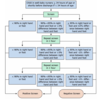Assessment and Care of the Newborn Flashcards
when is the transition period after birth?
first 4-6 hours of life
what happens during the transition period?
- closure of the ductus arteriosus
- lung expansion with clearance of alveolar fluid
- increased blood flow to lungs
- decreased pulmonary vascular resistance
how do we prevent heat loss in the newborn?
- hats
- skin contact with mother
- swaddling
- dry and remove wet linens
what is a normal core temperature in a neonate?
36.5-37.5 (97.7-99.5)
what is a normal neonate response to cold stress?
vasoconstriction
increased muscle flexion
metabolism of glucose, brown fat
when does glycogen storage increase in a fetus?
during the 3rd trimester
what affects post-birth blood glucose levels?
- hyperinsulinemia (diabetic mother)
- inadequate glycogen stores (pre-term)
- increased glucose utilization (stress, other congenital anomalies)
what do hypoglycemic neonates present with?
- lethargy
- poor feeding
- tachypnea
- jitteriness
- hypothermia
when screening for glucose, when do you want to do the first glucose level?
- first 30 minutes -1 hour of life (after the first feeding)
- measure pre-feeding glucose every 3-6 hours for 24-48 hours
what is normal heart rate in a neonate?
120-160 bpm
85-90 may be normal in a sleeping infant
what is the normal rr in a neonate?
40-60 breaths/min
tachypnea can be a sign of respiratory/cardiac disease
apnea - due to maternal meds, neuro impairment, sepsis
what color is normal in a newborn?
central cyanosis is abnormal
acrocyanosis (peripheral) - normal in 1st 48 hours
when are apgar scores done?
1 minute and 5 minutes
what are the components of the Apgar?
- heart rate
- breathing
- grimace
- activity
- appearnance
what vitamin do you typically receive in the first few hours of life?
IM Vitamin K
why do newborns have low Vitamin K at birth?
- can’t synthesize it
- low placental transfer from mother
- can’t store it
what is Vitamin K bleeding in the early days called?
hemorrhagic disease of the newborn
what are the signs of hemorrhagic disease of the newborn
bruising, mucosal bleeding
bleeding at umbilicus or circumcision site
intracranial hemorrhage
what is put in the eyes in the neonate and what is used to prevent?
erythromycin 0.5% ophthalmic oinment
prevents gonococcal and chlamydia opthalmia neonatorum
when is an infant considered extremely premature?
very premature?
late pre-term?
early term?
28 weeks or less
28 weeks to 31 6/7 weeks
32 weeks to 36 6/7 weeks
37 weeks and 38 6/7 weeks
what are the birth weight criteria?
low birth weight <2500 gm
very low birth weight < 1500 gm
extremely low birth weight < 1000 gm
small for gestational age <10th percentile for GA
large for gestational age >90th percentile GA
what is the incidence of birth injuries?
1-2% (maybe lower for C-section)
what are the different extracranial birth injuries?

how can you tell a caput succedaneum from a cephalohematoma?
in caput, there is burring on the skin of the scalp





